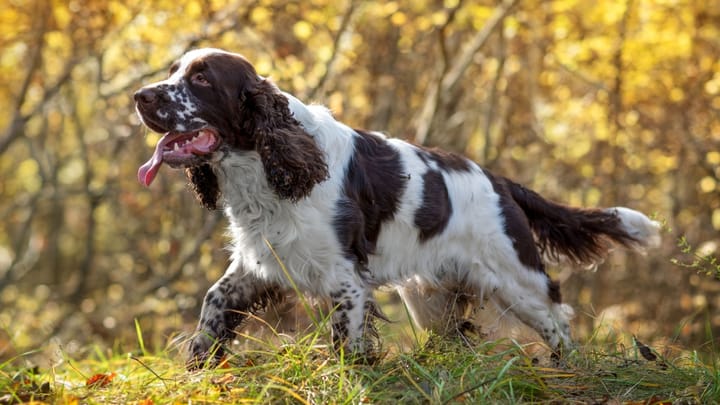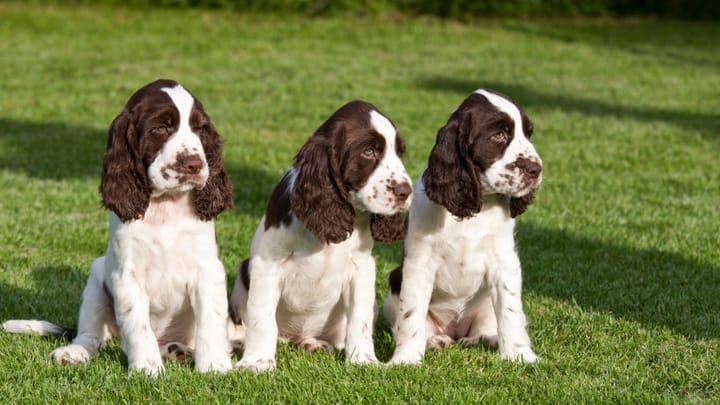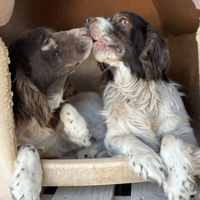English Springer Spaniel
Other name: Springer


The English Springer is a very affectionate and friendly dog, nice with children, calmer than the Cocker Spaniel, even if he is rather active. The English Springer is a versatile hunting dog. Since he is as comfortable on the ground as in the water, he is able to hunt and work; but he is also great as a companion dog.
|
Life expectancy |
The English Springer Spaniel has a life expectancy of between 12 and 14 years |
|
Temperament |
|
|
Size |
Medium
|
|
Adult size |
Female
Between 19 and 21 in
Male
Between 19 and 21 in
|
|
Adult weight |
Female
Between 40 and 49 lb
Male
Between 40 and 49 lb
|
|
Coat colour
The coat can be bicolour (black and white or liver and white), black, white and tan, liver and white, liver, white and tan or tricolour with tan markings. |
Black White Brown |
|
Type of coat
The fur is mid-length. The fur is straight, tight and offers protection from the weather. Fringes appear on the ears, the anterior and posterior limbs and the body. |
Long |
|
Eye colour
The eyes are dark hazel-coloured. |
Brown
|
|
Purchase price |
The English Springer Spaniel costs between £500 and £610 |
He is the oldest of British hunting dogs.
More details about the English Springer Spaniel
English Springer Spaniel: Origins and history
The Springer, as his full name indicates, originated in England. This breed has been known for more than 2,000 years, although he was not ‘recognized’ as a breed until the end of the nineteenth century. A hunter, Gaston Phoebus, the Count of Foix, kept many of them and contributed to their fame. But it was only after the Second World War that the breed began to gain reputation. British Islanders have been able to keep and develop those qualities of Spaniels that have become valuable to hunts taking place in difficult access areas. The breed was recognised by the English Kennel Club and the American Kennel Club in 1910 and by the CFI in 1954.
Physical characteristics of the English Springer Spaniel
The general view is that of a symmetrical, strong, compact, joyful and active dog. Among the Spaniels, the English Springer is the largest and has the most character and charm. His head is structured around a medium-length, fairly wide, slightly rounded skull, and a snout with a length proportional to the skull, wide and deep, well positioned under the eyes. Those eyes, averagely sized, have a soft expression. They are almond-shaped. The ears, which flap down from the head, have a good length and width and are located at the height of the eyeline. The tail is directed downwards, well-fringed, and always lively; it never surpasses the dorsal line.
FCI classification of the English Springer Spaniel
-
Group 8 - Retrievers - Flushing Dogs - Water Dogs
-
Section 2 : Flushing Dogs
English Springer Spaniel: Characteristics
English Springer Spaniel: Behaviour
Training a English Springer Spaniel
The English Springer Spaniel is perhaps the most docile of the hunting dogs. He wants above all to please his master, in fact, he does not like disputes or punishment. Education must therefore be positive, rewarding and encouraging of good behaviour.
However, this does not mean that his master shouldn’t be firm, consistent, and self-confident when teaching the basic lessons (leash walking, recall, and appropriate behaviour).
English Springer Spaniel: Lifestyle
Breed compatibility English Springer Spaniel
English Springer Spaniel: Purchase price
The price of an English Springer varies depending on his origins, age and gender. An average of £610 is asked for a dog registered with the Kennel Club.
The average budget to support a dog of this size is around £35/month.
English Springer Spaniel: Shedding
Average
Shedding is moderate but ongoing in this breed. Moulting is regular and intensifies in the autumn and spring when brushing must take place daily.
English Springer Spaniel: Grooming
This dog's coat does not require special grooming and is easily maintained as long as you are diligent and regular in weekly brushing. However, his fringes require special attention to avoid the formation of knots.
English Springer Spaniel: Health
The life expectancy is estimated at 13 years.
He is a very robust, sturdy and long-lived dog.
Like many active and working dogs, he doesn’t appreciate heat very much. Indeed, during intense effort, exhaustion can happen quickly, so it is not advisable to make him work in a very intense way when it is very hot.
His tight coat offers him protection from bad weather. In fact, he doesn't really fear the cold and can even live outside. Attention must be paid all the same to extreme climatic conditions.
Since he is very active, the Springer has substantial physical expenditure, so if he has a balanced diet, there is no justification for excessive weight gain.
- Alpha-Fucosidosis (dysfunction of an enzyme)
- Primary Seborrhoea (disease that reaches the skin and hair follicles)
- Ventricular Communication (Heart malformation)
- Coxo-femoral dysplasia








